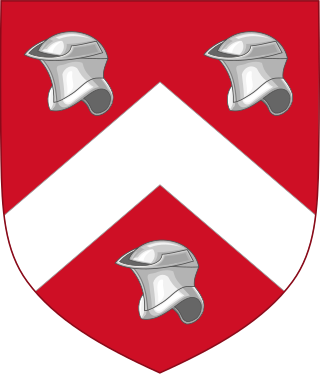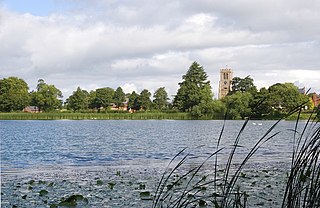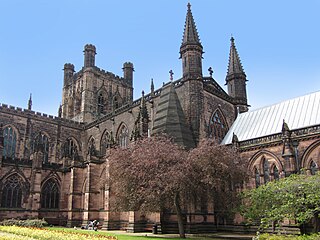
Rev. John Lloyd DCL (1533-1607) was a Welsh lawyer, Judge of the High Court of Admiralty in London, board member of All Souls College, and a cofounder, along with Queen Elizabeth Tudor, of the first Protestant College at the University of Oxford.

Rev. John Lloyd DCL (1533-1607) was a Welsh lawyer, Judge of the High Court of Admiralty in London, board member of All Souls College, and a cofounder, along with Queen Elizabeth Tudor, of the first Protestant College at the University of Oxford.


John Lloyd was born in 1533, the third son of David Lloyd of Cevn Amwlch, in Lleyn, Carnarvonshire. He resided at Hartshorne, Derbyshire, and at his lodge in London. He married Elizabeth Pigott of Doddershall, daughter of Thomas Pigott (Bedfordshire MP), the High Sheriff of Buckinghamshire. [1] His brother-in-law was Thomas Pigott, Justice of the Peace, while his nephew, Thomas Pigott (Aylesbury MP), was son-in-law of Sir John Allot, the Lord Mayor of London.
Lloyd obtained his Bachelor of Arts degree from the University of Oxford in 1542. He was a Fellow of All Souls College, member of the governing body of Oxford University. [2] He received the degrees of Bachelor of Civil Law in 1554 and Doctor of Civil Law in 1565. He became an advocate of the Canterbury Court of the Arches in 1566, and later, Judge of the High Court of Admiralty in London. [3] Lloyd worked under Lord Admirals, Edward Clinton, 1st Earl of Lincoln, husband of Elizabeth FitzGerald, and Charles Howard, 1st Earl of Nottingham, cousin of Elizabeth I and Anne Boleyn.

As a Judge of the High Court of Admiralty, Lloyd had to deal with maritime issues, such as acts of piracy, and captures of warfare vessels and merchant ships by ennemies or competitors. He also had to settle the rights between merchants, seamen, and ship-owners. The Admiralty Court was considered a merchant's court, designed to protect the rights of traders, and dealt with the problems they encountered with pirates. [4] Lloyd worked during an important period of change, the Tudor period, which marked the beginning of the British Empire. [5]
With improvements in ship technology, capital financing, and with the discovery of new colonies around the world, Britain developed a policy of commercial and overseas expansion. [6] The reforms of Henry VIII, and later of Elizabeth Tudor, allowed the Admiralty Court to flourish as they were able to deal with more matters related to law and finance, such as commercial disputes, freight and charterparty, bills of exchange, lading, insurance, and hypothecation of ships. [7] This opened the way for Lloyd, who was an ambitious lawyer, as they needed more Judges to deal with the increasing complexity of maritime trade.

In April 1559, Lloyd was appointed Dean of St Asaph in Wales but was removed from this position in November the same year. [8] In 1571, he was named in a charter granted by Queen Elizabeth I as one of the eight founding fellows of Jesus College, Oxford. That College was the first Protestant college at the University of Oxford and was the only college created there by Elizabeth Tudor. [9] [10] [11] [12] Members of that charter, along with John Lloyd, were the Secretary of State, William Cecil of Burghley House; the Lord Chancellor of England, Sir Christopher Hatton of Holdenby Palace; the Lord Keeper of the Great Seal, Nicholas Bacon of Old Gorhambury House, and a few others.
There was in total 8 founding fellows, 8 founding commissioners, 8 founding scholars, and a Principal. In 1589, Elizabeth Tudor issued a new Charter, reducing the members from 22 to 13, making all of them Commissioners with no more Fellows or Scholars. John Lloyd was one the thirteen founding Commissioners appointed by the Queen and was promoted from Fellow to Commissionner. Before Jesus College was founded, Lloyd had also been the Principal of White Hall at the University of Oxford. [13] He died in February 1607 and was buried in the Minster (church) at Chester Cathedral, in England.
John Lloyd was a member of the Griffith family of Cevn Amwlch, who rose to power after challenging the supremacy of the Wynn family of Gwydir. [14] [15]

Members of his family included :
John Lloyd children included :

Elihu Yale was a British-American colonial administrator and philanthropist. Although born in Boston, Massachusetts, he only lived in America as a child, spending the rest of his life in England, Wales, and India. He became a clerk for the East India Company at Fort St. George, and eventually rose to President of the settlement. He later lost that position under charges of corruption for self-dealing and had to pay a fine. In 1699, he returned to Britain with a considerable fortune, around £200,000, mostly made by selling diamonds, and spent his time and wealth in philanthropy and art collecting. He is best remembered as the primary benefactor of Yale College, which was named in his honor, following a sizable donation of books, portrait, and textiles under the request of Rev. Cotton Mather, a Harvard graduate. No descendants of his have survived past his grandchildren.

Sir Owen Tudor was a Welsh courtier and the second husband of Queen Catherine of Valois (1401–1437), widow of King Henry V of England. He was the grandfather of Henry VII, founder of the Tudor dynasty.

Theophilus Eaton was a wealthy New England Puritan merchant, diplomat and financier, who took part in organizing and financing the Great Puritan Migration to America. He was a founder of Massachusetts Bay Colony, and a founder and eventual governor of New Haven Colony. He also cofounded Boston, Massachusetts, Greenwich, Connecticut and Eaton's Neck in New York.

Sir David Hanmer, KS, SL (c.1332–1387) was a fourteenth century Anglo-Welsh Justice of the King's Bench from Hanmer, Wales, best known as Owain Glyndŵr's father-in-law and the father of Glyndŵr's chief supporters.

Gruffudd Fychan II was Lord of Glyndyfrdwy and Lord of Cynllaith Owain c.1330–1369. As such, he had a claim to be hereditary Prince of Powys Fadog, and was a member of the Royal House of Mathrafal. His son, Owain Glyndwr, started the Welsh Revolt and became Prince of Wales.

James Murray Yale was a clerk, and later, a Chief trader for the Hudson's Bay Company, during the late North American fur trade, as they were competing with the Montreal-based North West Company and the American Fur Company of John Jacob Astor. During his career, he would negotiate and compete with Americans, French Canadians, Russians, and Indians for market shares. He is best remembered for having given his name to Fort Yale, British Columbia, which became the city of Yale during the gold rush, and later on, became the name of the Yaletown district of downtown Vancouver.
This article is about the particular significance of the century 1601–1700 to Wales and its people.
This article is about the particular significance of the century 1501–1600 to Wales and its people.
This article is about the particular significance of the century 1401–1500 to Wales and its people.

Ial or Yale was a commote of medieval Wales within the cantref of Maelor in the Kingdom of Powys. When the Kingdom was divided in 1160, Maelor became part of the Princely realm of Powys Fadog, and belonged to the Royal House of Mathrafal. Yale eventually merged with another commote and became the Lordship of Bromfield and Yale, later a royal lordship under the Tudors and Stuarts.

The Royal House of Mathrafal began as a cadet branch of the Welsh Royal House of Dinefwr, taking their name from Mathrafal Castle. They effectively replaced the House of Gwertherion, who had been ruling the Kingdom of Powys since late Roman Britain, through the politically advantageous marriage of an ancestor, Merfyn the Oppressor. King Bleddyn ap Cynfyn would join the resistance of the Anglo-Saxon King Harold Godwinson, against the invasion of William the Conqueror, following the Norman conquest of England. Thereafter, they would struggle with the Plantagenets and the remaining Welsh Royal houses for the control of Wales. Although their fortunes rose and fell over the generations, they are primarily remembered as Kings of Powys and last native Prince of Wales.

Tudur ap Gruffudd (1365–1405), also known as Tudor de Glendore or Tudor Glendower, was the Lord of Gwyddelwern, a junior title of the princely house of Powys Fadog, and was the younger brother of Owain Glyndŵr, the Welsh rebel leader crowned Prince of Wales. His father was Gruffydd Fychan II, the hereditary Prince of Powys Fadog and previous Lord of Gwyddelwern. Along with his brother, Owain Glyndŵr, Tudur was a member of the royal House of Mathrafal.
This article is about the particular significance of the year 1734 to Wales and its people.
John Griffith (V) was a Welsh politician who sat in the House of Commons from 1715 to 1740.

Sir Simon Weston (1565–1637) was an English Knight and politician, personal ally of the Earls of Essex, who sat in the House of Commons between 1624 and 1626. He was involved in the Earl's of Essex rebellion against Queen Elizabeth Tudor.

Thomas Yale was the Chancellor, Vicar general and Official Principal of the Head of the Church of England : Matthew Parker, 1st Lord Archbishop of Canterbury, and Edmund Grindal, Bishop of London, during the Elizabethan Religious Settlement. He was also Dean of the Arches and Ambassador to his cousin, Queen Elizabeth Tudor, at the Court of High Commission.

Bryneglwys is a village and community in Denbighshire, Wales. The village lies to the northeast of Corwen on a hill above a small river, Afon Morwynion, and is situated in the ancient commote of Iâl (Yale). The community covers an area of 9.45 square miles (24.5 km2) and extends to the top of Llantysilio Mountain. It had a population of 369 at the time of the 2011 census, an increase from 344 during the 2001 census.

David Yale was the Chancellor of Chester, England and a correspondent of Elizabeth Tudor's chief minister, Lord William Cecil of Burghley House. He was also the Vicar General of his in-law, Bishop George Lloyd of Chester. His son, merchant Thomas Yale, became the patriarch of the Yale family of America, and the grandfather of governor Elihu Yale, benefactor of Yale University.

Ellis ap Griffith (c.1440-1489) or Elissau ap Gruffudd, was the Baron of Gwyddelwern in Denbighshire, Wales, and the grandnephew of Owen Glendower, Prince of Wales. Following his family defeat during the Glyndwr Rising, his branch inherited the co-representation of the Royal House of Mathrafal, and were immortalized by William Shakespeare in the history play Henry IV. Through his mother Lowrie, he inherited the lordship of his grandfather, Tudor Glendower, and by marriage, the estate of Plas-yn-Yale. By this union, he became the founder of the House of Yale, represented by the Yale family, later known in America as the benefactors of Yale University.